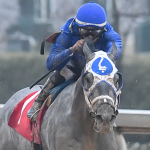
Preakness Quick Sheet: Get to Know the 2021 Preakness Horses

The history of horse racing is filled with the names of talented fillies and mares that challenged male horses and beat them in the world’s greatest races. Names like Zenyatta, Rachel Alexandra, Black Caviar, Tepin, and Goldikova resonate with current racing fans thanks to their accomplishments on the sport’s biggest stages.
In the 1930s, there was an established program of stakes races for 2-year-old and 3-year-old fillies, but older mares weren’t as lucky and had few major races to target. Purse money and prestige were reserved for the open races typically dominated by colts, so for an older mare to have a shot at earning respect (and good prize money), she had to step outside her division and challenge males.
Few mares have ever done so with more long-term success than Esposa. Sired by Espino out of the mare Quick Batter, pictures reveal Esposa to have been a fairly plain chestnut mare with a short tail and a light-colored spot on her neck. Bred and owned by William Ziegler, Jr. and trained by Matt Brady, Esposa may have been unremarkable in appearance, but she had the heart of a champion within. Racing in the 1930s against a strong group of male horses that included Seabiscuit, War Admiral, and Discovery, Esposa held her own against all of them, and—on one memorable occasion—even defeated Seabiscuit.
To recap all of Esposa’s vast accomplishments would require an entire book—from 1934 through 1940, she ran in 96 races!—so we’ll instead focus on her amazing record at Saratoga, where she was a force to reckon with whenever she ran. In recent years, Saratoga has been the site of some memorable victories by fillies against their male rivals; in 2009, Rachel Alexandra scored a historic win in the Woodward Stakes, and Havre de Grace repeated the feat in 2011. But their accomplishments pale when one considers the breadth of Esposa’s achievements at the Spa.
Right from the beginning, Esposa found herself racing against colts. As a 2-year-old in 1934, she competed in the prestigious Hopeful Stakes at Saratoga and finished a solid third, but this was only the tip of the iceberg. In 1935, Esposa’s campaign got much bolder, and she hit the board in four stakes races against colts at Saratoga. A third-place finish in the Saranac Stakes against her own age group was respectable, but she ran even better when tackling older males in races like the Whitney Handicap, Champlain Handicap, and Saratoga Cup. In the Whitney, she found herself facing future Horse of the Year Discovery and ran a huge race to finish second by two lengths; in the Saratoga Cup, she was second again behind fellow 3-year-old Count Arthur, but ran well to finish ahead of 1932 Belmont Stakes winner Faireno.
Her runner-up effort in the Whitney would have been remarkable in and of itself, but it was only the first of four times that Esposa would compete in the prestigious race. As a 4-year-old, she returned to Saratoga and turned the tables on Discovery in the 9.5-furlong Merchants’ and Citizens’ Handicap, winning by a length over Count Arthur with Discovery another 5 ½ lengths back in fifth, but Discovery rebounded to win the Whitney Handicap two weeks later, leaving Esposa far behind in second place. During that same meet, Esposa also finished second in another renewal of the Champlain Handicap.

In 1937, with Discovery retired, Saratoga was free for Esposa to conquer, and conquer she did. During an unprecedented campaign, she won four stakes races against males and hit the board in another. The Delaware Handicap and Wilson Stakes were solid prizes at a mile in distance, but she also won the Saratoga Handicap and Whitney Handicap going 10 furlongs, with the latter victory marking the third straight time that she had finished first or second in the Whitney. She even attempted to stretch her speed to 1 ¾ miles in the Saratoga Cup, in which she finished a solid third behind Count Arthur and Matey.
Later in the year at Empire City and Pimlico, Esposa won three straight stakes races, including the Bowie Handicap by a nose over Seabiscuit. The Nov. 20, 1937 edition of The Blood-Horse magazine described the win as Esposa’s “crowning achievement” and applauded her courage in out-dueling Seabiscuit in the final 20 yards. Thanks to this victory, plus her spectacular exploits at Saratoga, Esposa was voted champion handicap mare.
Esposa’s last season of major success came in 1938, and while the presence of 1937 Triple Crown winner War Admiral prevented her from dominating Saratoga like in the past, Esposa still had a good meet. Running six times, she finished third to War Admiral in the Wilson Stakes at the start of the meet, then came within a neck of upsetting the champion in the Saratoga Handicap. Later in the meet, she won her second Champlain Handicap, finished second by a length to War Admiral in the Whitney Handicap (her fourth straight top-two finish in the race!), and then trailed War Admiral home by four lengths when second in the Saratoga Cup. Based largely on these efforts, she was voted co-champion handicap mare of 1938.
Esposa would run only once in 1939 and four times in 1940, with her only top-three finish being a runner-up effort in the 1940 Wilson Stakes at Saratoga. The great mare retired with a record of 19 wins, 23 seconds, and 13 thirds from 96 starts, with earnings of $132,055—not bad at all given the low purse money of the 1930s, and good enough to rank her third at the time among the highest-earning fillies and mares in U.S. racing history. But it was the sheer depth of her accomplishments against colts in major stakes races at Saratoga—six wins, nine seconds, and four thirds—that has earned her a place in the history books.